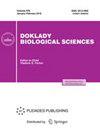克里米亚早更新世(Taurida 洞穴)的猎豹 Acinonyx pardinensis(猫科,食肉动物)。
Q3 Agricultural and Biological Sciences
Doklady Biological Sciences
Pub Date : 2024-10-01
Epub Date: 2024-08-28
DOI:10.1134/S0012496624701175
引用次数: 0
摘要
本文描述了来自 Taurida 洞穴早更新世地点(克里米亚,晚维拉弗朗西期,约 1.8-1.5 Ma)的 Acinonyx pardinensis (Croizet et Jobert, 1828) 下颌骨碎片。这是首次在克里米亚的更新世发现角马属。猎豹与其他猫科动物,如Homotherium、Megantereon、Panthera、Lynx和Puma一起,是欧亚大陆晚维拉弗朗西期动物群的典型代表。在 Taurida 地点,Achinonyx pardinensis 与 Homotherium crenatidens、Megantereon adroveri 和 Lynx issiodorensis 共同出现。本文章由计算机程序翻译,如有差异,请以英文原文为准。

Cheetah Acinonyx pardinensis (Felidae, Carnivora) from the Early Pleistocene of Crimea (Taurida Cave).
A mandible fragment of Acinonyx pardinensis (Croizet et Jobert, 1828) is described from the Early Pleistocene locality in the Taurida cave (Crimea, Late Villafranchian, about 1.8-1.5 Ma). This is the first discovery of the genus Acinonyx in the Pleistocene of Crimea. Along with other felids, such as Homotherium, Megantereon, Panthera, Lynx, and Puma, cheetahs were typical representatives of the Late Villafranchian faunas of Eurasia. In the Taurida locality, Acinonyx pardinensis is co-occurred with Homotherium crenatidens, Megantereon adroveri, and Lynx issiodorensis.
求助全文
通过发布文献求助,成功后即可免费获取论文全文。
去求助
来源期刊

Doklady Biological Sciences
Agricultural and Biological Sciences-Agricultural and Biological Sciences (all)
CiteScore
1.10
自引率
0.00%
发文量
66
期刊介绍:
Doklady Biological Sciences is a journal that publishes new research in biological sciences of great significance. Initially the journal was a forum of the Russian Academy of Science and published only best contributions from Russia in the form of short articles. Now the journal welcomes submissions from any country in the English or Russian language. Every manuscript must be recommended by Russian or foreign members of the Russian Academy of Sciences.
 求助内容:
求助内容: 应助结果提醒方式:
应助结果提醒方式:


